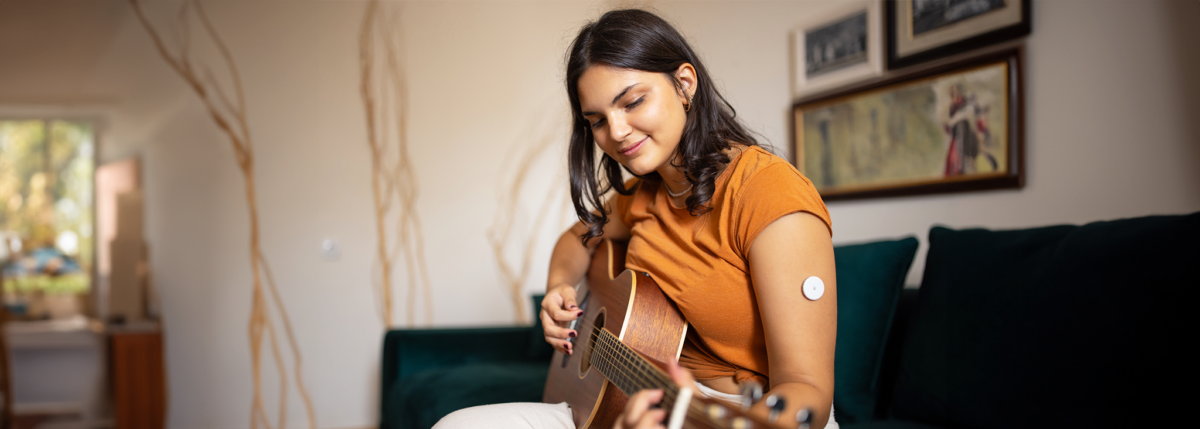Why Newly Diagnosed People With Type 1 Diabetes Should Consider a Continuous Glucose Monitor (CGM)
Being a newly diagnosed person with type 1 diabetes comes with a learning curve. For optimal control and safety, you have to learn about insulin, food, blood-sugar management, and even glucagon. As a newly diagnosed person with type 1 diabetes, it might also behoove you to consider a continuous glucose monitoring (CGM) system.
What is a Continuous Glucose Monitor (CGM)?
Continuous Glucose Monitors—also known as CGMs—are wearable technology.
CGMs make it easier to track your blood-sugar fluctuations and trends. They do this by continuously measuring interstitial-fluid glucose levels.
Then, they report the collected data every 1-15 minutes.
Data collected by these systems are sent to a transmitter. Then, they are displayed in various devices.
Currently, four companies manufacture personal CGM devices in the United States:
- Abbott (Freestyle Libre, Libre 2, and Libre 3)
- Dexcom (Dexcom G7)
- Medtronic (Guardian Connect and Guardian Sensor 3), and
- Senseonic’s Eversense.
By allowing for the ability to track dynamic blood-sugar fluctuations and trends over time, CGMs have revolutionized type-1-diabetes management.
- CGMs allow for optimization of medical therapy and the prevention of dangerous events—like hypoglycemia.
- People with type 1 diabetes who use CGMs swear by their ability to continually monitor blood-sugar levels and give real-time updates through a device that is attached to your body.
- CGMs sound alerts if your blood sugar is too low or high.
- CGMs also provide a good way to monitor “time in range,” which is the amount of time you spend in the target blood-sugar range—between 70 and 180 mg/dL for most people.
What Are the Parts of a Continuous Glucose Monitor?
CGM systems are made up of three components:
- The sensor (a small wire catheter that is inserted under the skin on your arm or abdomen).
- A transmitter that attaches to the sensor, and
- A handheld receiver and/or smartphone that displays your blood-sugar data in real time.
The Sensor
- You place the sensor just under your skin—usually on your belly or arm.
- Adhesive tape holds the sensor in place.
- The sensor measures blood-sugar levels in the interstitial fluid under your skin
You’ll usually need to change the sensor regularly based on the device—every 7 to 14 days.
The Transmitter
- All CGM systems use a transmitter to wirelessly send the blood-sugar data from the sensor to a device where you can view it.
- For some CGM systems, the transmitter is part of the disposable sensor.
The Handheld Receiver and/or Smartphone
- Depending on the CGM system, blood-sugar data from the sensor is sent to either a handheld device called a receiver (similar to a cell phone), an app on your smartphone or an insulin pump.
- You can download CGM data (real-time blood-sugar levels, trends and history) to a computer anytime. Some CGM systems will continuously send data.
-
- You can also share the information with your provider.
-
Why is a Continuous Glucose Monitor Great for Diabetes Self Management?
There are several reasons for a person with type 1 to consider a CGM.
Real-time CGM monitoring has led to tremendous outcomes for people with type 1 diabetes who—without a CGM—may have experienced potentially life-threatening complications.
The Centers for Disease Control says that regular blood-sugar monitoring is the most important thing a person with type 1 diabetes can do, as it lets you see what makes your numbers go up or down.
A March 2024 study that appeared in JAMA Network Open found that CGMs could help reduce the likelihood of vision-related complications like diabetic retinopathy in people with type 1 diabetes.
CGMs are great for diabetes self management because they let you monitor the effects of the following on your blood-sugar levels:
- Different foods
- Times of day
- Activity levels, and
- Illness.
Another reason for a type 1 to consider a CGM is because CGMs are also beneficial for patients’ caregivers and loved ones who participate in diabetes management.
While self monitoring of blood sugar (i.e. finger-stick testing) provides a “snap-shot” of your of blood-sugar concentration—but is limited by the number of finger-sticks you are willing to perform each day—CGMs can report up to 288 blood-sugar readings per day—yes, you correctly read that.
Other ways that CGMs provide significant—potentially life-changing—benefits for diabetes management are that they:
- Help avoid or delay serious, short- and long-term diabetes complications.
- Potentially save money through improved diabetes management and fewer events, like hypoglycemia leading to emergencies.
- Offer people with diabetes and their health care team more details about blood-sugar levels than traditional blood-glucose meters—giving the opportunity to analyze the data more precisely than ever before.
- Provide biofeedback in real time, which allows people with diabetes to modify their dietary pattern or insulin dose based on trends, as directed by their health care provider. This may reduce your risk of hypoglycemia and hyperglycemia (high blood sugar).
Will I Ever Need to Do a Finger-stick Test If I Use a Continuous Glucose Monitor?
For some CGM models, you may need to do a finger-stick test with a standard blood-glucose monitor to calibrate the system and make sure the CGM readings are correct.
The Cleveland Clinic states that a finger-stick check may give you peace of mind if your CGM device shows rising or falling numbers—despite you feeling okay.
It can also provide answers if you don’t feel well—but the CGM says your blood-sugar levels are in target.
How Much Does a Continuous Glucose Monitor Cost?
CGM devices can be expensive.
More and more insurance providers cover them today, which may make the cost more affordable.
Your health insurance policy may only cover certain CGM devices.
Keep in mind that you’ll regularly need to replace sensors and possibly transmitters.
Check with your insurance provider to see what devices and supplies your plan covers.
Many providers and CGM companies have resources to help make CGM more affordable for those who need it.
This content was made possible by Abbott, a Founding Partner of Beyond Type 1.
Beyond Type 1 maintains editorial control over its content.





